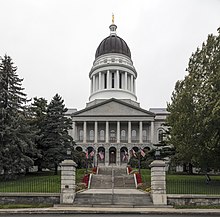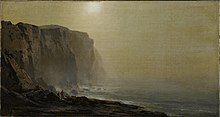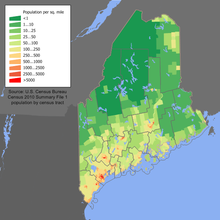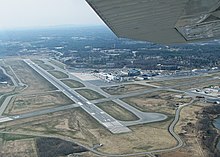Maine
The first European settlement in the area was by the French in 1604 on Saint Croix Island, founded by Pierre Dugua, Sieur de Mons.A number of English settlements were established along the coast of Maine in the 1620s, although the rugged climate and conflict with the local Indigenous people caused many to fail.Today, Maine is known for its jagged, rocky Atlantic Ocean and bay-shore coastlines, mountains, heavily forested interior, and its cuisine, particularly wild lowbush blueberries and seafood such as lobster and clams.Coastal and Down East Maine have emerged as important centers for the creative economy,[14] especially in the vicinity of Portland, which has also brought gentrification to the city and its metropolitan area.[15] The earliest known inhabitants of the territory that is now Maine were Algonquian-speaking Wabanaki peoples, including the Passamaquoddy, Maliseet, Penobscot, Androscoggin, and Kennebec.During the later King Philip's War, many of these peoples would merge in one form or another to become the Wabanaki Confederacy, aiding the Wampanoag of Massachusetts and the Mahican of New York.[16][17] European contact with what is now called Maine may have started around 1200 CE when Vikings are believed to have interacted with the native Penobscot in present-day Hancock County, most likely through trade.[18] The first European confirmed settlement in modern-day Maine was in 1604 on Saint Croix Island, led by French explorer Pierre Dugua, Sieur de Mons.A second settlement was attempted in 1623 by English explorer and naval Captain Christopher Levett at a place called York, where he had been granted 6,000 acres (24 km2) by King Charles I of England.Justifying its actions with a 1652 geographic survey that showed an overlapping patent, the Massachusetts Bay Colony had seized New Somersetshire and Lygonia by force by 1658.[22] The Abenaki took captives taken during raids of Massachusetts in Queen Anne's War of the early 1700s to Kahnewake, a Catholic Mohawk village near Montreal, where some were adopted and others ransomed.In the wooded areas of the interior lies much uninhabited land, some of which does not have formal political organization into local units (a rarity in New England).Along the famous rock-bound coast of Maine are lighthouses, beaches, fishing villages, and thousands of offshore islands, including the Isles of Shoals which straddle the New Hampshire border.This visual contrast of forested slopes sweeping down to the sea has been summed up by American poet Edna St. Vincent Millay of Rockland and Camden, in "Renascence":[34] All I could see from where I stood Was three long mountains and a wood; I turned and looked the other way, And saw three islands in a bay.Geologists describe this type of landscape as a "drowned coast", where a rising sea level has invaded former land features, creating bays out of valleys and islands out of mountain tops.Prominent glacial features include Somes Sound and Bubble Rock, both part of Acadia National Park on Mount Desert Island.By analyzing the type of granite, geologists discovered that glaciers carried Bubble Rock to its present location from near Lucerne, 30 miles (48 km) away.Most severe thunderstorms and tornadoes occur in the southwestern interior portion of the state,[39] where summer temperatures are often the warmest and the atmosphere is thus more unstable compared to northern and coastal areas.[44] Maine's terrestrial fauna comprises mammals such as moose, black bears, and white-tailed deer, along with smaller species like red squirrels, snowshoe hares, and raccoons.[45] Avian diversity is evident with migratory birds like piping plovers, American oystercatcher, and northern harrier, as well as resident species like black-capped chickadees, blue jays, and barred owls.Freshwater habitats support fish species like brook trout, landlocked salmon, and multiple gamefish, while marine life in offshore waters includes Atlantic puffins, harbor seals, minke whales, and lobster.[50] As explained in detail under "Geography", there are large tracts of uninhabited land in some remote parts of the interior of the state, particularly in the North Maine Woods.The upper Saint John River valley area was once part of the so-called Republic of Madawaska, before the frontier was decided in the Webster-Ashburton Treaty of 1842.Smaller numbers of various other groups, including Irish, Italian, Swedish[70] and Polish, have settled throughout the state since the late 19th and early 20th century immigration waves.According to the Association of Religion Data Archives in 2020, with Christianity as the dominant faith, the largest denominations by number of adherents were Catholicism (219,233 members), non-denominational Protestantism (45,364), and United Methodists (19,686).Formerly a large support base for the U.S. Navy, the BRAC campaign initiated the Naval Air Station's closing, despite a government-funded effort to upgrade its facilities.[102] Portland International Jetport has been expanded, providing the state with increased air traffic from carriers such as JetBlue and Southwest Airlines.Maine has very few large companies that maintain headquarters in the state, and that number has fallen due to consolidations and mergers, particularly in the pulp and paper industry.Its ships stop in Portland once a week in a route that includes Atlantic Canada and Iceland with connections to northern Europe and Asia.[142] Maine food shares many ingredients with Wabanaki cuisine, including corn, beans, squash, wild blueberries, maple syrup, fish, and seafood.

Arthur Parton (1842–1914). Between 1865 and 1870, Brooklyn Museum .



















Maine (disambiguation)NicknamesMotto(s)DirigoAnthem:State of MaineUnited StatesMassachusettsDistrict of MaineAdmitted to the UnionCapitalAugustaLargest cityPortlandLargest county or equivalentCumberlandLargest metroGovernorJanet MillsSenate PresidentMattie DaughtryLegislatureState LegislatureUpper houseSenateLower houseHouse of RepresentativesJudiciaryMaine Supreme Judicial CourtU.S. senatorsSusan CollinsAngus KingU.S. House delegationChellie PingreeJared GoldenMount KatahdinAtlantic OceanMedian household incomeDemonymSpoken languageEnglishFrenchTime zoneEasternUSPS abbreviationISO 3166 codeTraditional abbreviationList of state symbolsFlag of MaineSeal of MaineSloganBlack-capped chickadeeButterflyPink-edged SulphurCat breedMaine CoonCrustaceanLobsterLandlocked Atlantic salmonFlowerWhite pine cone and tasselWild blueberryInsectHoney beeMammalWintergreenWhite pineBeverageBlueberry pieWhoopie pieFossilPertica quadrifariaGemstoneTourmalinepegmatiteBowdoinState quarterLists of United States state symbolsNew EnglandLower 48New HampshireGulf of MaineCanadian provincesNew BrunswickQuebecNova Scotia50 U.S. states12th-smallest by area9th-least populous13th-least densely populatedmost populous city2020 censusIndigenous populationslast ice ageAlgonquianWabanaki ConfederacySaint Croix IslandPierre Dugua, Sieur de MonsPopham ColonyPlymouth CompanyIndigenous peopleLoyalistPatriotAmerican RevolutionWar of 1812CanadaColony of New Irelandpeace treatyCommonwealth of MassachusettsMissouri Compromiseforestedwild lowbush blueberriesseafoodDown East Mainecreative economythe vicinity of PortlandgentrificationHistory of MaineMaine State HouseCharles BulfinchBrooklyn MuseumPassamaquoddyMaliseetPenobscotAndroscogginKing Philip's War
